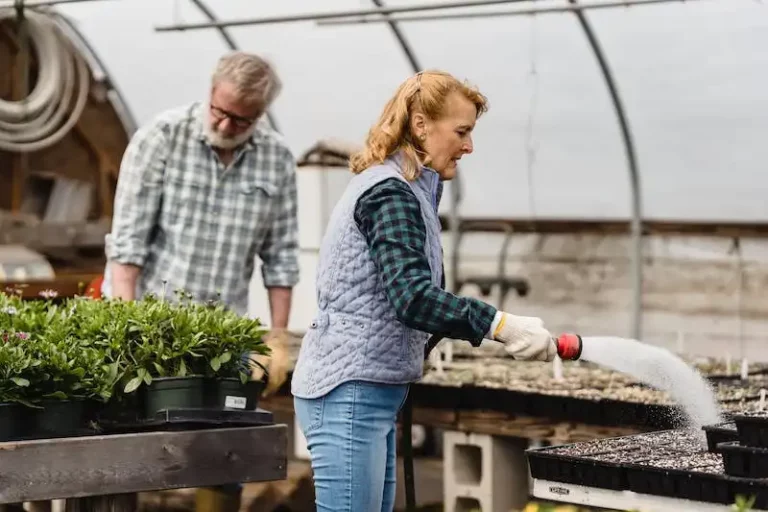If you love vines and have a green thumb, then you’re probably familiar with the Pothos plant. This hardy and versatile plant is known for its lush, green foliage and long, trailing stems. However, if you’ve tried and failed to propagate Pothos through rooting, don’t give up just yet! There are several reasons why your Pothos cuttings may not be rooting successfully, but fear not – we’re here to help you troubleshoot and find a solution.
One common reason why Pothos cuttings won’t root is that they may be too damaged or lacking in nutrients. Before starting the propagation process, be sure to inspect the stems for any signs of rotting or yellowing. If you notice any damaged or rotting parts, prune them off before attempting to root the cutting. Additionally, make sure that the Pothos plant is well-fed and has access to enough water and sunlight, as this will give it the energy and resources it needs to grow new roots.
Another factor that may affect Pothos rooting is the cleanliness of the roots. If the roots are clogged or dirty, they may not be able to properly absorb water and nutrients, leading to failed rooting attempts. To remedy this, you can gently rinse the roots under running water to remove any dirt or debris. This will help ensure that the roots are in optimal condition for root development.
Furthermore, it’s important to consider the type of rooting medium you’re using. Pothos plants prefer a well-draining medium that provides good aeration and moisture retention. If you’re using a medium that is too compact or doesn’t hold enough moisture, the cutting may not be able to root properly. You can try using a mixture of perlite and potting soil, or a specialized rooting mix, to give your Pothos cutting the best chance at rooting success.
When it comes to fertilizing your Pothos, less is often more. While it’s important to provide the plant with enough nutrients, over-fertilizing can actually hinder root growth. Instead of using a regular fertilizer, consider using a diluted rooting hormone or an oxygenating fertilizer. These types of fertilizers can help promote root development without causing excessive foliage growth.
In conclusion, if your Pothos cuttings are not rooting, there are several factors to consider and potential solutions to try. By inspecting and pruning damaged parts, cleaning the roots, using the right rooting medium, and providing appropriate fertilization, you can increase your chances of success. Remember, propagating plants can be a bit of trial and error, so don’t be discouraged if your first attempts don’t work out. With a little patience and fine-tuning, you’ll be able to rescue your Pothos and enjoy the beauty of new, rooted plants.
How to Save a Plant from Root Rot – Top Tips
If you’re dealing with a plant that is suffering from root rot, don’t panic! There are steps you can take to salvage your plant and bring it back to health. Root rot occurs when the roots of a plant become waterlogged, leading to damage and decay. Here are some top tips for saving a plant from root rot:
| 1. | Inspect the roots: Carefully remove the plant from its pot and examine the roots. Healthy roots will be firm and white, while rotting roots will appear soft or mushy and may be discolored. |
| 2. | Clean the roots: Gently remove any damaged or rotting roots by trimming them back to healthy tissue. Use clean scissors or pruning shears to avoid spreading any potential diseases. |
| 3. | Repot the plant: Choose a clean container with drainage holes and fill it with a well-draining potting mix. This will help prevent water from sitting around the roots and causing further damage. |
| 4. | Water the plant correctly: After repotting, make sure to water the plant thoroughly but allow the soil to dry slightly between waterings. Overwatering can lead to root rot, so be mindful of how much water your plant needs. |
| 5. | Adjust the watering schedule: If you suspect that overwatering is the cause of root rot, fine-tune your watering routine. You may need to water less frequently or use a well-draining soil mix. |
| 6. | Provide proper drainage: Ensure that the pot or container you use has adequate drainage holes to allow excess water to escape. Standing water at the bottom of the pot can lead to root rot. |
| 7. | Consider the season and temperature: Some plants may need less water during the dormant season or when temperatures are cooler. Adjust your watering habits accordingly to prevent over-saturation. |
| 8. | Improve airflow: If your plant is in a container, consider placing it in an area with good air circulation. This will help prevent moisture buildup and promote root health. |
| 9. | Apply a diluted hydrogen peroxide solution: Hydrogen peroxide can help to kill off bacteria and fungi that may be causing root rot. Mix one part hydrogen peroxide with three parts water and apply it to the plant’s roots. |
| 10. | Give it time: Saving a plant from root rot can be a slow process. Be patient and monitor your plant closely for signs of improvement or new growth. It may take several weeks or even months for your plant to fully recover. |
Remember, prevention is always better than a cure, so make sure to provide your plants with the proper care and conditions they need to thrive. By following these top tips, you can increase the chances of saving a plant from root rot and bringing it back to its healthy, green state.
How to save a plant from root rot
If you’ve noticed that your plant’s roots are damaged and rotting, it’s important to take immediate action to rescue the plant and save its survival. Root rot can be caused by overwatering, poor drainage, or a fungal infection, and if left untreated, it can lead to the plant’s death. Here are some steps you can take to help your plant recover and thrive again:
1. Inspect and remove affected roots: Start by inspecting the roots of your plant and removing any rotted or mushy parts. Use clean, sharp scissors or pruning shears to cut away the damaged roots. Be sure to cut back to healthy, green tissue to prevent the spread of infection.
2. Repot in fresh soil: Choose a new container with sufficient drainage and fill it with fresh, well-draining potting soil. Gently remove the plant from its old container, taking care not to damage the remaining healthy roots. Place the plant in the new container and add soil around the roots, gently firming it in place. Ensure the plant is at the same level as before.
3. Provide proper care: After repotting, give your plant the right care to promote its recovery. This may include adjusting watering habits, providing sufficient light, and using a balanced fertilizer to support regrowth. Avoid overwatering and be sure to let the soil dry out slightly between waterings to prevent further root rot.
4. Increase oxygenation: Increased oxygenation can help the roots recover from rot. One way to do this is by adding oxygenating additives to the water, such as hydrogen peroxide or aquarium airstones. These can promote healthy root growth and discourage the growth of harmful bacteria.
5. Use rooting hormones: If you’re propagating the plant from cuttings, using rooting hormones can increase the chances of success. These hormones help stimulate root growth and encourage the development of new roots on the cutting.
6. Maintain the right temperature: Avoid exposing the plant to extreme temperatures or drafts. Keep it in a location with temperatures between 65 and 75 degrees Fahrenheit (18 to 24 degrees Celsius) to promote optimal growth.
7. Monitor and adjust: Keep a close eye on your rescued plant and monitor its progress. Look for signs of new growth, healthy leaves, and strong roots. If any issues arise, adjust your care routine accordingly to ensure the plant’s survival.
8. Time and patience: Saving a plant from root rot is not a quick fix. It can take several months for the plant to fully recover and start growing again. Be patient and give it the time it needs to regain its strength.
By following these steps, you can give your plant the best chances of recovering from root rot and thriving once again. Remember, prevention is also key – ensure proper watering and drainage practices to avoid the recurrence of root rot in the future.
In conclusion, if you’re faced with a plant suffering from root rot, don’t lose hope. With the right care, attention, and a little bit of time, you can rescue and revive your plant back to its former glory.
What root rot looks and smells like
Root rot is a common problem that can affect the health of your pothos plants. It occurs when the roots of the plant start to decay due to overwatering or poor drainage. If you notice any of the following signs, there is a good chance that your pothos is suffering from root rot:
- Dark and mushy roots: When you inspect the roots of your pothos, they may appear dark and mushy. This decay is a clear indication that your plant is struggling.
- Foul odor: Another sign of root rot is a strong, unpleasant smell coming from the roots. The smell is often described as a musty or rotten smell.
- Drooping or yellowing leaves: As the roots decay, the plant’s ability to uptake water and nutrients is compromised. This can result in drooping or yellowing leaves.
If you suspect that your pothos has root rot, it is important to take action to prevent further damage and potentially save the plant. Here are a few steps you can take:
- Remove the affected parts: Carefully prune away any rotted roots or foliage. Be sure to sanitize your pruning tools between cuts to avoid spreading the rot to healthy parts of the plant.
- Change the soil: Remove the plant from its current pot and gently shake off any excess soil. Inspect the roots and remove any remaining rotted portions. Repot the pothos in fresh, well-draining soil.
- Improve drainage: Make sure that the pot you use has drainage holes to allow excess water to escape. You can also add a layer of gravel or perlite to the bottom of the pot to improve drainage.
- Adjust watering: Water your pothos only when the top inch of soil feels dry to the touch. Overwatering is the most common cause of root rot, so be careful not to overdo it.
- Provide proper lighting: Pothos plants thrive in bright, indirect light. Make sure to place your plant near a window where it can get enough light, but avoid direct sunlight.
In addition to these steps, it is important to consider the conditions in which your pothos is growing. Check the temperature, air circulation, and humidity levels to ensure they are within the appropriate range. This will promote healthy growth and prevent future cases of root rot.
If you have followed all these steps and your pothos does not show signs of improvement within a few months, it may be time to accept that the plant cannot be saved. In this case, it is best to start anew with fresh cuttings or propagate new plants from healthy parts of the mother plant.

